Oakland Athletics: Who Will Win the Remaining Bullpen Job?

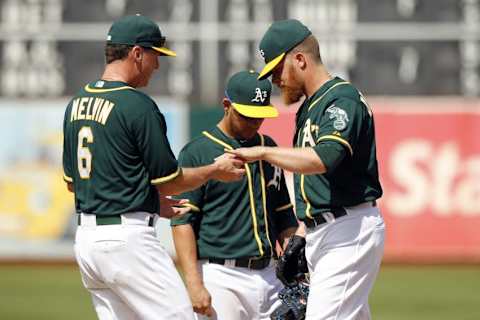
Which Oakland Athletics Reliever Will Win the Final Bullpen Job?
Going to back to at least 2012, the Oakland Athletics have opened the season with seven relievers on their major league roster. Teams vary from six to seven bullpen arms, based on their bench needs, but the A’s have been pretty consistent in selecting an extra pitcher over an extra position player each year.
So far this spring, six of the potential bullpen spots seem to be locks for 2016. Lefty Sean Doolittle will be the team’s closer, with a supporting cast of right-handers Ryan Madson, Liam Hendriks, John Axford and Fernando Rodriguez. Marc Rzepczynski will be the team’s left-handed specialist. That leaves just one possible opening for all of the other relief pitchers in camp.
While there have been many pitchers to take the mound for the Athletics this Spring Training, the majority of them will not be in consideration for a major league job, and in the end, all but one of them will start their season in the minors or on another team. On Monday, the Athletics knocked two more potential relievers from the list when they optioned J.B. Wendelken and Andrew Triggs to Triple-A Nashville.
That leaves four players who have some potential to make the cut: two left-handers and two right-handers. Who will win the battle for the last remaining bullpen spot?
Starting with the least likely option, let’s take a look at the possibilities:
Next: #4: A right-hander with a new pitch
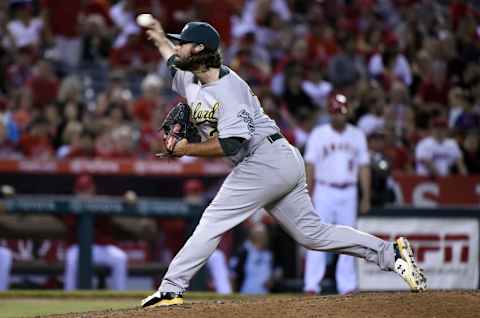
Right-Hander R.J. Alvarez
The Athletics have a shortage of left-handed options in the ‘pen, considering the fact that Doolittle will be reserved for the closer role. That just leaves Rzepczynski, who can’t possibly pitch every day. This factor does not bode well for the first name on our list: right-hander R.J. Alvarez.
Alvarez might not seem like one of the best relief options in camp, given his 9.90 ERA over 20 innings last season, but he has a few things going for him.
First of all, Alvarez is only 24 years old.
He’s hardly a finished product, so to write him off over one bad season would be a mistake. When he made his 10-game major league debut with San Diego in 2014, he posted a 1.13 ERA, allowing just one earned run, three hits and five walks in eight innings, while striking out nine batters.
Of course, it’s that high walk rate that hurts him.
With the Padres, he had a 15.2 percent walk rate, and last season in 20 innings as an Oakland A, he allowed a free pass to 13 percent of batters. That’s not too far off from double the league average.
Coming into camp, the young right-hander announced that he has added a two-seam fastball to his repertoire, and he’s lost some weight. He also spent the winter working on his delivery, trying to find a solution for his consistency issues.
However, so far this Spring Training, Alvarez has appeared in three games, pitching 3.1 innings and facing 19 batters. He’s allowed four hits and a pair of runs, while striking out two.
The biggest concern though, remains his control: two walks and three hit batsmen.
Spring Training isn’t the best source for determining if a pitcher will be successful, but Alvarez’s continued inconsistently proves that he needs a bit more time in the minor leagues to work on his new pitch and mechanics. Later in the season, he could be a key contributor for the A’s. As of right now, it seems likely that he’ll be one of the players who yo-yo between the minors and the majors when injuries and ineffectiveness create a need at the big league level.
Next: #3: A left-hander with a new pitch
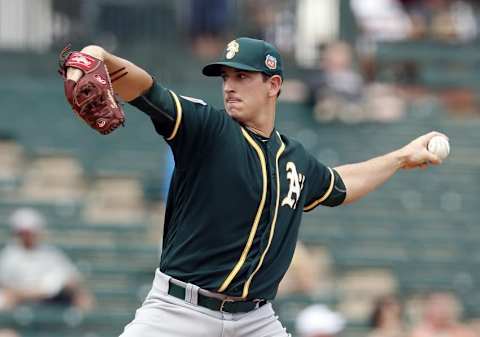
Left-Hander Eric Surkamp
There’s a 2010 NPR radio spot by contributor Frank Deford, in which he half-jokingly states that parents who want to give their sons every advantage in life should save their money on expensive education and experiences.
“Instead, tie his right arm behind his back as soon as he gets out of the crib and teach him to be a left-handed relief pitcher, and that kid of yours will still be making a good living pitching when you’re in assisted living.”
Of course, Deford was not being literal, but he has a point. Alvarez wound up fourth on this list, not because he’s less of a pitcher than Eric Surkamp, but because Surkamp has the decided advantage of being a lefty. The Athletics will not be able to rely on Rzepczynski the entire season, and they also don’t have a lot of flexibility in the event of a short start or extra-inning game, given that most of their bullpen arms are veteran major leaguers. Even though Surkamp is probably the inferior pitcher to Alvarez, his handedness makes him a better candidate.
Surkamp’s most used pitch is his four-seam fastball, which sits somewhere between the high 80s and low 90s.
According to FanGraphs, he also throws a cutter, curveball and changeup. All in all, he’s a pretty standard left-handed relief pitcher.
He appeared in just one game for the Dodgers last season, giving up four earned runs in 3.1 innings. Prior to that, however, he was moderately successful as a White Sox reliever (at least by left-handed standards). Surkamp posted a 4.81 ERA in 35 appearances out of the bullpen for Chicago.
The 28-year-old also missed all of 2012 after having Tommy John surgery.
The reason the Athletics’ were intrigued by Surkamp, who began his career in the San Francisco Giants’ system, has to do with his cutter. That’s a new pitch for him, and they think it could add a new element to his game.
So far this spring, Surkamp has posted a 4.50 ERA in three games. Over six innings of work, he’s allowed three runs, three walks and nine hits, while striking out three batters. He’s done a fairly good job of limiting the damage – that averages out to two baserunners each inning, and he’s kept them from scoring – but he’ll have to get better at reducing the overall traffic, because those runners could come back to haunt him.
Surkamp is another pitcher who could be useful to the A’s later in the season, either out of the bullpen or at the back-end of the rotation, if necessary. In the meantime, he’s more useful to the A’s as a starter in the minor leagues. The organization’s starting depth is very weak, and they can use someone like Surkamp to fill out their Triple-A rotation. Because he signed a minor league deal, the A’s don’t have to worry about the fact he has no options left – at least to start the season. It will limit the amount of situations they are able to call him up in later on, given that he would have to clear waivers to return to the minors.
Next: #2: The best right-handed option
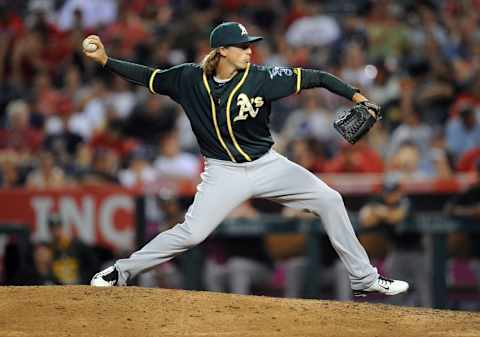
Right-Hander Ryan Dull
Easily the best arm of the bunch, Ryan Dull should be at the very top of this list. It’s been stated numerous times, both on this site and by the A’s staff, that Dull has impressed this spring with his composure. Despite his small stature – Dull is just 5’10” and 175 pounds – he’s been a force against opposing Cactus League hitters. He’s kept batters off-balance and has given up just two hits and a walk in 3.2 innings. He’s also struck out five of the 17 batters he’s faced.
Dull, who was drafted in 2012, has risen steadily through the system.
He made his debut with the A’s in 2015, pitching 11 scoreless innings to start his career. By the end of the season, he had posted a 4.24 ERA over 17 innings. He also struck out 16 and walked just six batters – the walk rate is a tad high, but so is the strikeout rate, giving him fairly respectable numbers for a rookie reliever on a bad team.
More interestingly, four of his eight earned runs were home runs. Dull had never given up home runs at a disproportionate level before, with his minor league home run per-nine rate always coming in at 1.5 or lower. It seems possible that this was a fluke, meaning his ERA should have been lower that it really was last season. His 4.05 xFIP, which normalizes his home run rate to league average and accounts for both good and bad defense, seems to support the fact that with fewer home runs, Dull could be even more successful. The gap between his ERA and FIP would be even larger if he had fewer walks, so seeing him cut back on those in Spring Training is certainly a good sign.
Dull’s most impressive outing the spring came when he found himself in a bases-load, no-outs situation.
A pair of errors and a walk got him into the jam, but he quickly struck out two batters and induced a fly out to escape the inning with no damage. The batter who walked was his fault, but the errors were not.
That is why is ability to strand runners is viewed as valuable here, whereas with Surkamp, it’s viewed as a liability. High left-on-base percentage is not always a good thing, because it typically shows that the pitcher has allowed a lot of traffic on the base paths. A better measurement is to see what percentage of inherited runners score, but Dull’s small 2015 sample size makes that nearly useless in this case. He allowed one of the three runners he inherited to score, but he was typically used in low-leverage situations, so it’s hard to determine his ability from such limited chances.
Regardless of how much of an asset Dull might be to the Athletics, the 26-year-old will likely begin his season in Triple-A due to the final name on this list.
However, unless Dull completely falls apart in Nashville, there’s no way that Oakland will be able to keep him there for long – no matter how many bullpen upgrades they made in 2016. The right-hander seems poised to have a big season for the Athletics.
Next: #1: The veteran left-hander
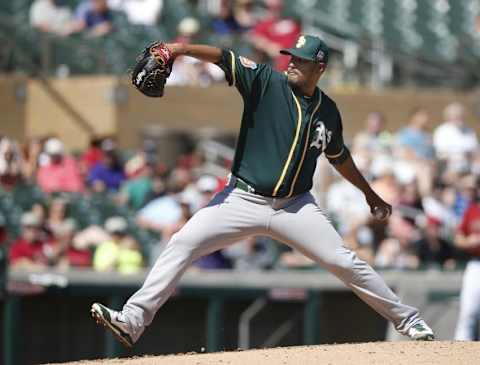
Left-Hander Felix Doubront
Felix Doubront is not a name that typically would top a list like this, but there’s one logical reason that he’s the most likely candidate to be with the big league club on Opening Day:
Doubront is out of options.
In addition, this is another instance where being a left-hander gives him a leg up on the other candidates. That’s not necessarily a knock on Doubront, as he’s had a pretty outstanding Spring Training. In eight innings, he’s posted a 3.38 ERA with nine strikeouts. He’s also allowed just eight hits, a walk and a hit batsman in those three games, although one of those outings was against primarily minor leaguers. And yet, the honest analysis says the Dull is the superior pitcher of the two.
However, Doubront can be something that Dull cannot: a left-handed option that works in either the bullpen or the rotation.
The Athletics have little depth at the starting pitching position, as mentioned earlier. Doubront is likely the first choice to fill the void this season if Jesse Hahn‘s injury issues flare up again, or if fellow-lefty Rich Hill continues to be a mess on the mound.
But because he has no options left, there’s no way for the Athletics to stash Doubront in the minors and call him up if they need him. The other names on this list either have options or, in Surkamp’s case, are on a minor league deal. In the eyes of an organization, that factor alone can make the decision, even if the team were stocked to the brim with pitching prospects. It’s not worth losing a reliable veteran arm to keep an unproven rookie on the roster.
Doubront is versatile and dependable, which makes him a good veteran option – but he also has a track record of very mediocre results.
With the A’s in 2015, he went 2-2 between eight starts and three relief appearances, finishing with a 5.81 ERA in 52.2 innings. He fared only slightly better in Toronto. This will be Doubront’s seventh major league season, and if he’s going to turn his career around, he needs to do it now. At 28 years old, Doubront is in his prime. If he can pitch in the regular season like he’s pitched in Spring Training, he can absolutely help the Athletics this year.
There are two caveats to the thought that Doubront will win the last reliever spot:
One is that he could always be traded, even if only for cash considerations. It seems unlikely, but stranger things have happened to the Athletics’ roster. If it did happen, that would be an unwise move. The A’s wouldn’t get much for him, and they are in need of a swing-man in the bullpen after the trade of Drew Pomeranz last winter.
The other caveat is that Doubront could slide into the rotation if the Athletics decide that one of their five projected starters is not ready, or if someone suffers a last-minute injury. That would give either of the other three candidates the opportunity to make the bullpen, with the edge going to Ryan Dull.
The idea that Doubront might beat out one of the other starters for an Opening Day rotation spot is pretty unlikely, though. Sonny Gray isn’t going anywhere, obviously, and the Athletics have promised the struggling Rich Hill a roster spot. Jesse Hahn appears healthy, although he’s struggled with the long ball in his first two starts. Chris Bassitt has yet to allow a run, and even though Kendall Graveman has had a rough spring, it seems unlikely that the A’s would knock him out of the rotation for Doubront. An injury is always a looming possibility, but there’s no way to predict if or when that might happen.
That means that Doubront is likely to start the season with the Athletics, while the other three names on this list will spend their Opening Day on the Triple-A roster. With six strong arms in the Athletics’ bullpen, that’s okay – Doubront’s ability to slide into the rotation is valuable enough to warrant keeping him on the roster.
Next: 2016 Preview: Sean Doolittle, The Closer
Will the Athletics go with the logical step of keeping Doubront on the roster, or will they take a gamble on one of the other young arms? Voice your thoughts and theories in the comments below.